

As we enter Benjamín Ossa’s new exhibition, happily titled Bringing home all that glow (Trayendo a casa todo ese fulgor), we see drawings in various media and formats, photography too, plus two kinetic sculptures that project a movable shadow play over the gallery space. By commenting on the materialities and poetics of each artwork, we will explore the depth that the exhibition conspires as a whole: how Ossa seeks a matrix in uncertainty and, in doing so, gives us clues about his intimacy, offering an entrance to the mystery that is always the everyday.
“I don’t know if things come, go, rise or fall” (“No sé si las cosas vienen, van, suben o bajan”). This is how the artist titled a previous series of his drawings. “I don’t know”: this declaration of uncertainty is typical of mystics. With that denial they warn us, in a Socratic tone, that the only thing they know is that they know nothing. “I don’t know” repeats three times César Vallejo – the most defiant poet of the Spanish language – in the opening poem of his first book. A warning sign hung on the portal that separates the conceptual from the sensible. Crossing beyond that sign, we may come to experience language in a way that ideas cannot to reduce. In a word, poetry: something made of language, but meant to transcend communication. With that triple dictum, Vallejo declares his mystical vocation. Ossa’s aforementioned title follows, “I don’t know if things…”: a touchdown in concrete experience. His uncertainty is that of the artist who thinks through the handling of his materials. About those things, the artist does not know if they “come, go, rise or fall”: he leaves us in the realm of relativity. Coherently, his drawings deepen in the most relative and therefore most challenging material of visual art: color. These are drawings that increasingly reflect about painting. With superposed layers of flat coloured papers and their resulting mixtures and shapes, Ossa repossess the visual grammar from its foundations, though with playfulness and improvisation. I call this mode of drawing “analytical games”.
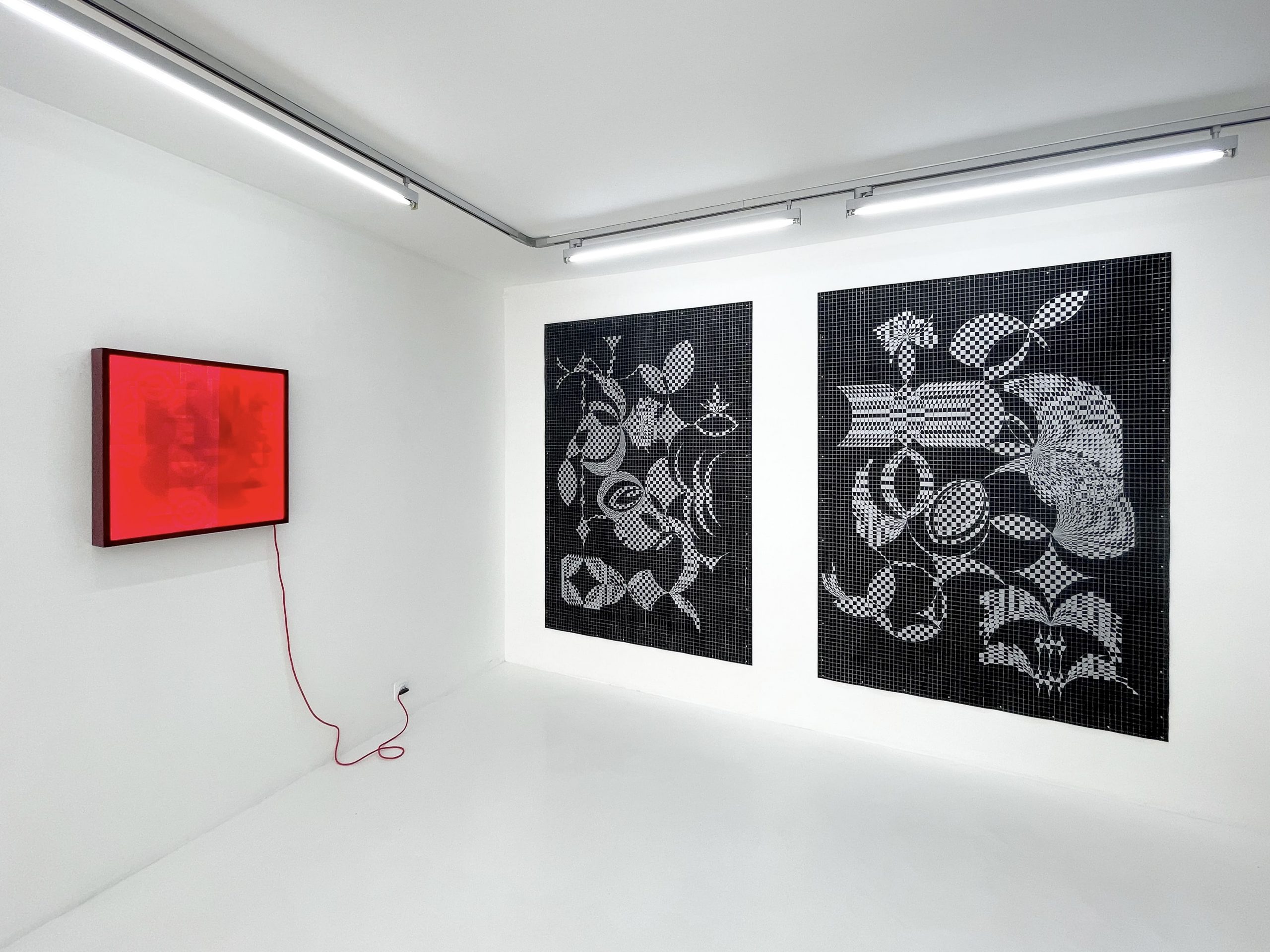
A good example of Ossa’s analytical games is the series of drawings entitled “Red net” included in Bringing home all that glow. They are cut drawings, characterised by semi-circular tabs cut and folded on the support that cast shadows, since the drawing’s support is back-lit. This is a way of drawing that Ossa has been exploring in variations since 2011. Ossa’s cuts are adorned with shadows proportional to the measure in which they either hide or reveal – that is, erotically – the source of light underneath the drawing. Imagining these drawings in relation to art that deals with architecture, I would say that Ossa opens Matta-Clark’s wall perforations in a scale and material similar to the models photographed by Thomas Demand. What shapes are laid by these shadows? Circles of varying size that bring to mind constellations of macro- and microcosms. Planets with moons around them, also atoms, molecules.
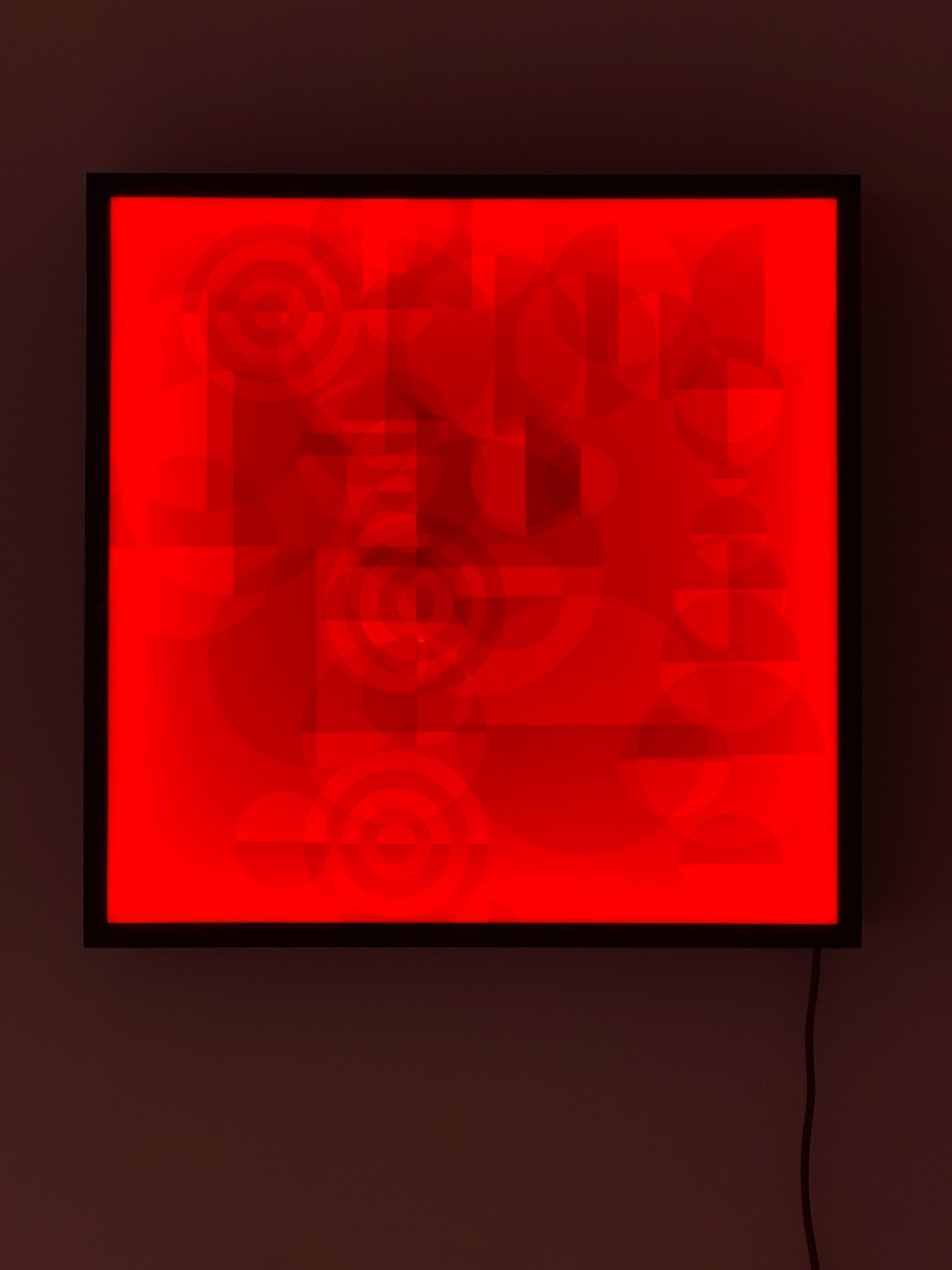
These circles float, impact one another; their radii sometimes suggest sonar waves or visualisations of networked echoes. They also recall compositions of Tomás Maldonado, an icon of Argentinian op art whose legacy is continued by Ossa’s drawings. In an interview, Ossa said that he likes how these shapes “float without a point of reference”, that he wants to “let them wander”: not knowing if they “come, go, rise or fall”. This speaks about a will to make art from hesitation, from the heart of doubt, and to keep this aspect of the making palpable in the finalised artwork and the way it is exhibited.
Circles. Centres. The artist has also said that “to stay concentrated” is one of the daily challenges of his artistic process. Who would not empathise, in this age of stimuli saturation? Ossa has also commented on the pleasure he takes in realising how his “different projects start to converge with each other”. As we see the superimpositions, echoes and radiations of the concentric and eccentric forms of these drawings, we might consider them as a visual embodiment of the convergence that the artist has found through a sustained search that already spans two decades.
The circle is the primordial. Not only in the ancestral past when a hypothetical hominid saw the full moon glowing round in the night sky and copied it in the sand with a stick, then with charcoal on the wall of a cave, from where millennia later wheels and coins rolled on the same shape— the circle also remains an incessant origin in the present. According to D. Winnicott, crucial childhood psychoanalyst, the circle represents the first symbol of the inner world for infants. The closed origin as a starting point. The womb that engulfed us, from which we are born exiles: the mother, that first other. Each new human life tends to recognise the circle before any other geometric form. Moreover, the perfection of the circle implies the closing of every course. From alpha to omega, it is the result of a movement, the fulfilment of a cycle. No wonder that sundials and most clocks are round! And that both time and movement are key concepts to understand Benjamin Ossa’s work.
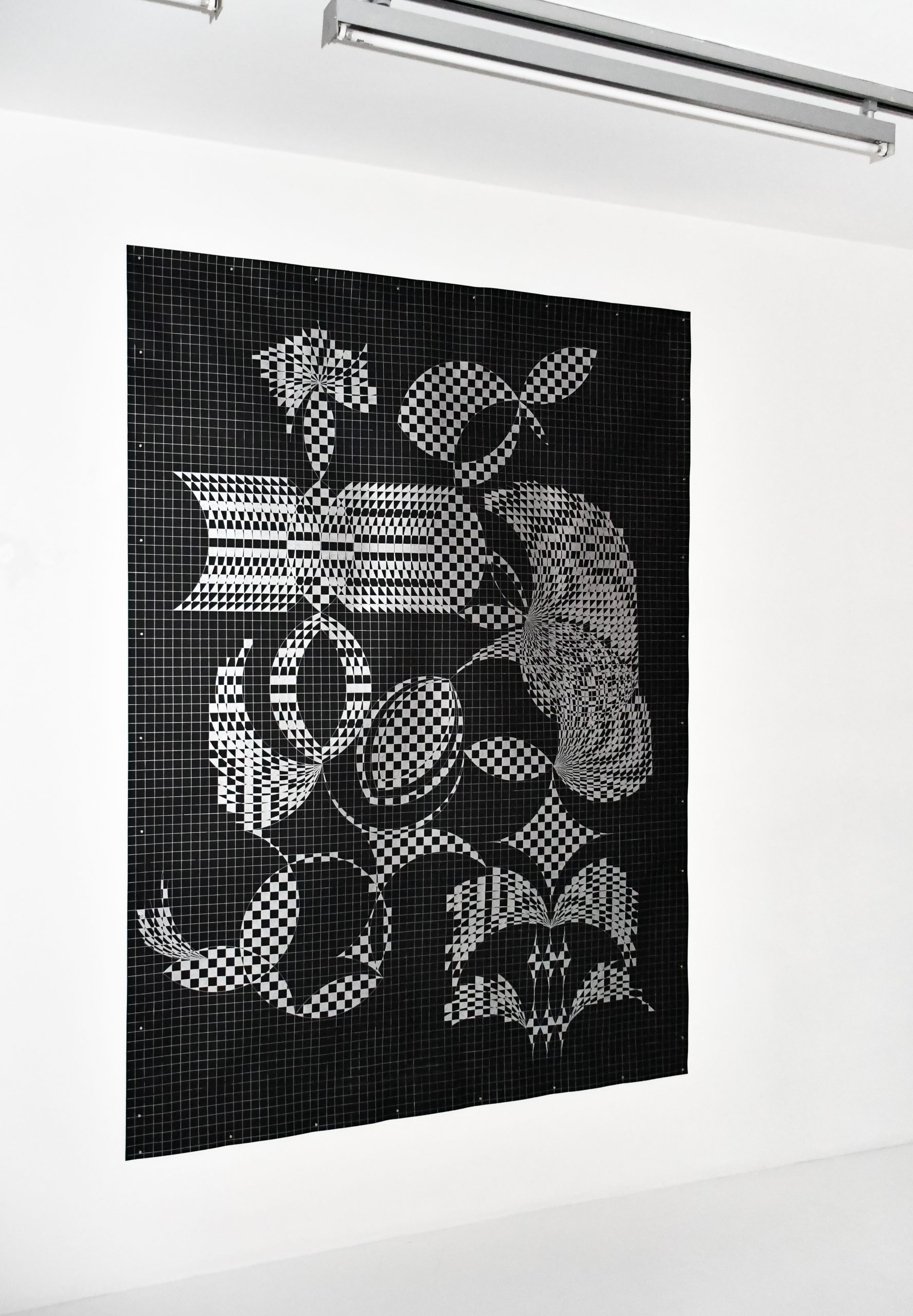
Serie Dibujos para perderse, 2022, Gel roller metallic on Canson paper 165 gr black mass, 201,2 x 152,2 cm.Further “Dibujos para perderse” (“Drawings to get lost”) complement the series mentioned above. They are large format drawings made with tiny gestures of silver ink on a black surface. Their title evokes their process: Ossa has begun by drawing a grid by hand; later, using a metal circle that is a remnant of a previous sculpture (and a preamble to the sculptures we will describe at the end of this text), he has traced curves that playfully converge. Faithful to his will for analytical gaming, the ever smaller zones that these converging curves circumscribe result in a sort of chessboard of progressively compressed checkboxes that are either filled with silver ink or left empty (in black), with labyrinthine tendency and an increasing openness to the aleatory. The more the gridded places are reduced, the more the handcraft becomes evident, which results – especially when looking at these works from a distance – in a certain vibration. That is why these drawings, departing from the control of the grid, are “to get lost”. About them, the architect G. Hevia has written “What differentiates these drawings from a precise edition made with digital tools? The existence of almost imperceptible errors, [milli]metric inconsistencies […], the impossibility of redoing or going back, [setting] the analog over the digital. Aspects that we might consider errors or imperfections are precisely those moments in which control is lost.”
Bringing home all that glow also includes a series of shattered mirrors. They are mirrors that Ossa broke on purpose, against the establishment of a reflection that threatens to stiffen identity. The resulting shreds draw a different kind of grid or net… a sort of random drawing that branches out like veins. Both the shape of their shredding and the material used (glass) are associated with the photographs described below.
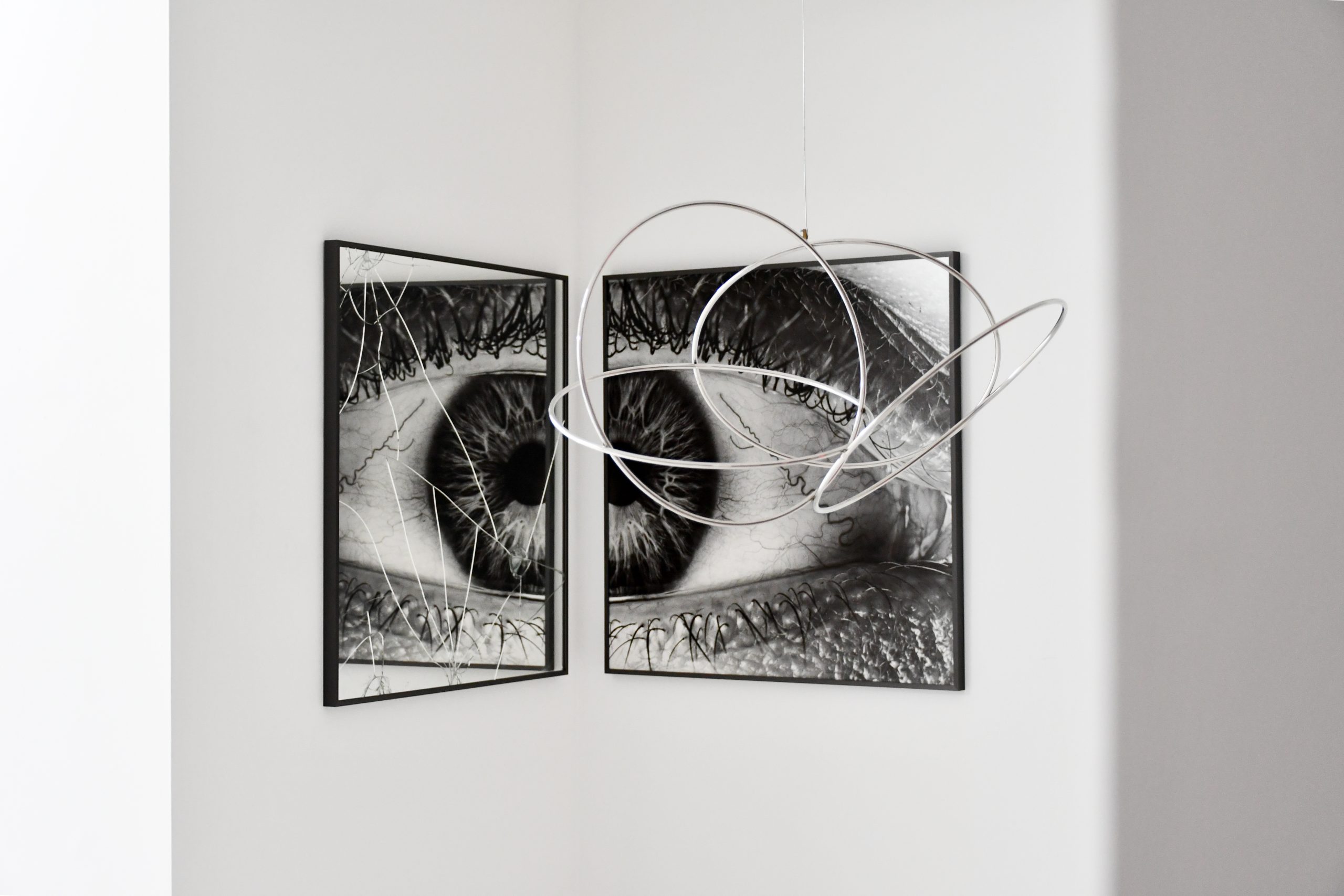
Two other photographs of the exhibition detail the veins of the artist’s eye, reddish and branching out over the whiteness of his sclera: hence their title, “Los hombres te miran te quieren tomar” (“Men look at you and want to take you”). Relating to the eye’s shape we also see some photographs of seeds. About seeds, Ossa has commented that “they become active when the environment is favorable”. Any material – whatever the temporal scale with which we regard it – accounts for moments of a process. Palpably organic matter, as is the case with seeds: they are things meant to be activated, just like Ossa’s artworks often depend upon the angle of our gaze and our movement through the exhibition hall (a feature they share with many works of Venezuelan op artist Carlos Cruz Diez). The fuchsia seeds photographed here are part of the artist’s personal object collection. About them, Ossa admits that “most of the ones I keep, I don’t know what tree they fell from or what plant they will rise to. They are usually gifts from my children.” For several years now, Benjamín Ossa has been seeding his children with the curiosity that makes him an artist. “Bring me whatever you find interesting,” he once encouraged them, after which they began bringing him stuff shown with the question, “Dad, will this do?”. Thus, the seed photos are aptly titled “¿y para quién?” (“and for whom?”). The association of the photographs of eyes and seeds with the shattered mirrors – and regarding them as recordings of intimacy – raises a chart of interlocked symbolisms.
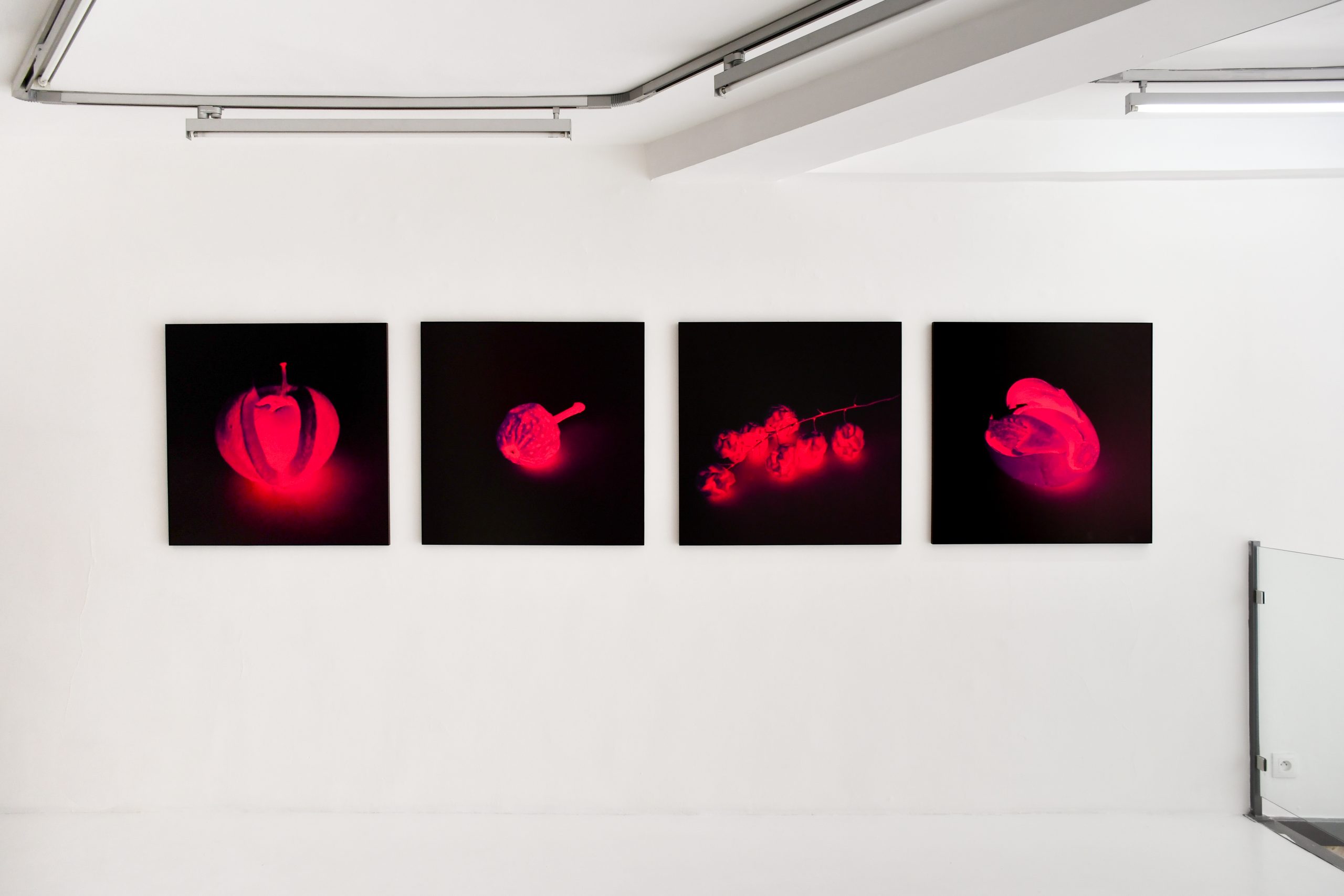
Entitled “En un momento vas a ver que ya es la hora de volver” (“In a moment you will see that returning is due”), the two sculptures of Bringing home all that glow are a summa summarum of the exhibition. They could be regarded as spatial drawings made of metallic circles. These circles make us think of the orbits represented in a planetarium that would omit the planets— though these are circles of equal diameter, not ellipses. An essential fact is that these are kinetic sculptures, which recalls the legacy another important Latin American artist Ossa’s work dialogues with: Julio le Parc. Their moving shadows cast shifting graphics over the gallery space.
The circles these sculptures consist of have the same diameter as the circular piece that Ossa used for tracing the curves of “Drawings to get lost”. These sculptures remind me of a comment by Hevia on the artist’s books, for, like those books, they provide “a window into the engine room that sets in motion his whole oeuvre”.
These moving sculptures and their shadows play a music of the spheres that binds together the whole exhibition. But the music played by these spheres is not universal— it is actually quite personal. Which invites us to clarify that the title of the exhibition is taken from a song written by Argentinian rock musician Luis Alberto Spinetta (Cantata de Puentes Amarillos, from the album Artaud, 1973) and that also “Los hombres te miran te quieren tomar” (the title of the photographs of the artist’s eye veins), “y para quién?” (the title of the photographs of seeds) and “En un momento vas a ver que ya es la hora de volver” (the title of the kinetic sculptures) also correspond to verses of the same song. This Spinetta song has accompanied the artist’s process in his atelier. The use of its verses as titles of artworks is a coordinating gesture that links us to Ossa’s laboratory of affects.
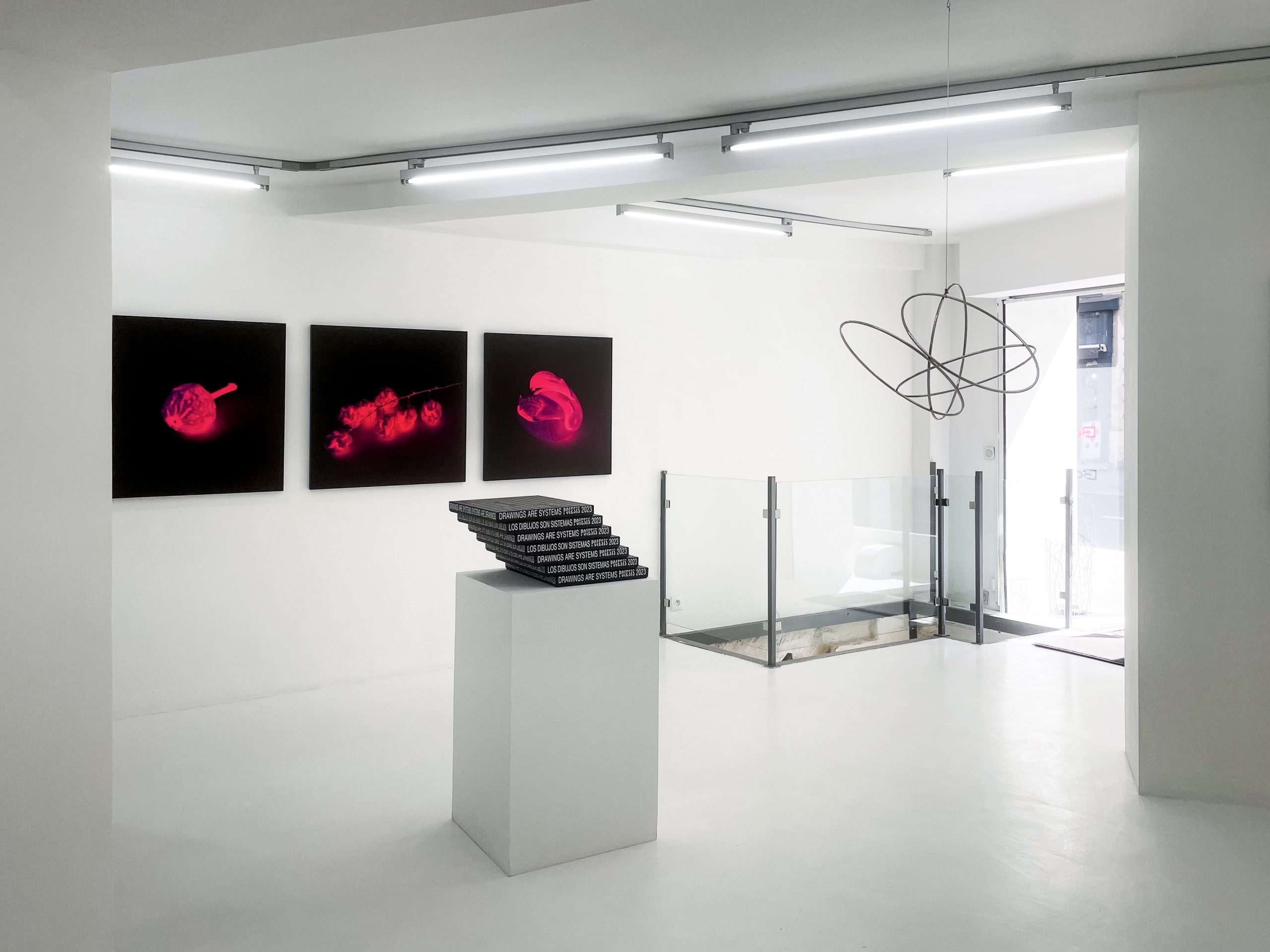
In Bringing home all that glow, Benjamín Ossa opens himself to uncertainty as his material of preference. He pursues it media after media, turning grids into games. Exposing his vulnerability, allowing the “I don’t know” of mystics to emerge and materialise. Letting go of certainties, he assumes the vertigo of what is not destined. The recurring shapes of Ossa’s compositions have reverberated in his intimacy and here return as affirmative echoes, resetting his work with greater affect. As a final comment that may underline the personal dimension of this exhibition, allow me the following confidence: the writer of this text is a poet once an artist who took part in some of Ossa’s first group shows. Since then, it has been a great joy to mutually follow the development and resonance of our work. Writing about his exhibition reaffirms a friendship that keeps bringing home all that glow.
Tomás Cohen, December 2022.